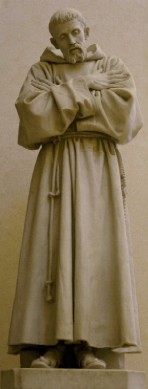
Browsing through the Catholic Encyclopedia, I found a few articles that are definitely worth a read to get a better understanding of the season of Lent.
Since tomorrow is Ash Wednesday, a good place to start is the entry on:
Ash Wednesdsay
(As a side note, I think I found a potential answer about the difference in the US and Rome. From the above article, it says that the faithful received ashes in the form of a cross upon their forehead, and that clerics would receive ashes in the form of a cross upon their tonsure (top of their head). One problem is that "tonsure" no longer exists. Another problem is that so many modernists don't like to distinguish between clerics and laity (as if that is something bad or clericalist). Not sure what or why the differences today.)
With that comes the observance upon Ash Wednesday (and Good Friday) of the:
Fast
On fascinating part mentions how fasting has been seen not only as just a religious observance, but also one of natural virtue as it fosters temperance.
It also explains many of the differences we have heard of in fasting, whether it be be not eating at all, having only one meal (The Black Fast), or having one normal meal with two small meals. Overall the conclusion becomes what is demanded by Church law and most importantly common sense.
Then this brings us fully into the season of:
Lent
Which shows a rather varied form of observance throughout the Church in both East and West due to Lent's rather "late" development compared to other annual feasts like Epiphany.
One interesting perspective was something of Saint Gregory the Great in looking at the fasting of Lent as a tithe to God:
"In the time of Gregory the Great (590-604) there were apparently at Rome six weeks of six days each, making thirty-six fast days in all, which St. Gregory, who is followed therein by many medieval writers, describes as the spiritual tithing of the year, thirty-six days being approximately the tenth part of three hundred and sixty-five."
And here are the relavent Canons on fasting and abstinence:
BOOK IV, PART III, TITLE II, CHAPTER II.
Days of Penance
Can. 1249 The divine law binds all the Christian faithful to do penance each in his or her own way. In order for all to be united among themselves by some common observance of penance, however, penitential days are prescribed on which the Christian faithful devote themselves in a special way to prayer, perform works of piety and charity, and deny themselves by fulfilling their own obligations more faithfully and especially by observing fast and abstinence, according to the norm of the following canons.
Can. 1250 The penitential days and times in the universal Church are every Friday of the whole year and the season of Lent.
Can. 1251 Abstinence from meat, or from some other food as determined by the Episcopal Conference, is to be observed on all Fridays, unless a solemnity should fall on a Friday. Abstinence and fasting are to be observed on Ash Wednesday and Good Friday.
Can. 1252 The law of abstinence binds those who have completed their fourteenth year. The law of fasting binds those who have attained their majority, until the beginning of their sixtieth year. Pastors of souls and parents are to ensure that even those who by reason of their age are not bound by the law of fasting and abstinence, are taught the true meaning of penance.
Can. 1253 The conference of bishops can determine more precisely the observance of fast and abstinence as well as substitute other forms of penance, especially works of charity and exercises of piety, in whole or in part, for abstinence and fast.
All of these articles are definitely worth a read, and can help give us a proper understanding and more focused observance of Lent.
RS






No comments:
Post a Comment